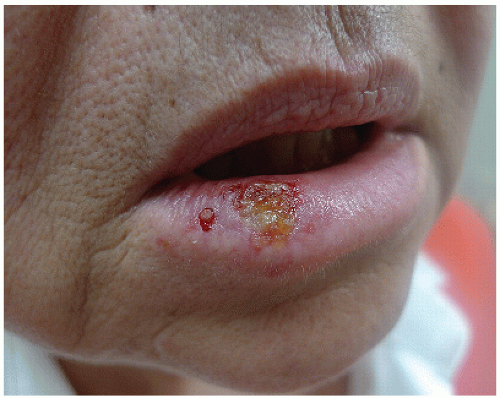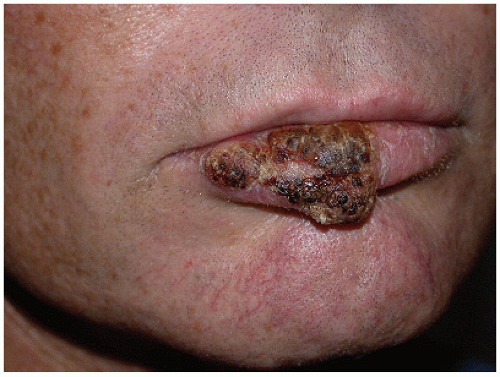Cancer of the Lip
John I. Song
INTRODUCTION
Due to its prominent location on the face, cancer of the lip is usually diagnosed early and is usually successfully treated. The American Joint Committee on Cancer defines the lips as part of the oral cavity that “begins at the junction of the vermilion border with the skin and includes only the vermilion surface or that portion of the lip that comes into contact with the opposing lip.” Unlike other malignancies of the oral cavity, cancer of the lip is more likely due to the cumulative damage caused by ultraviolet (UV) radiation than by tobacco and alcohol abuse. The lips are especially vulnerable to UV radiation as they lack a protective pigmented layer. Prolonged exposure to sunlight has been shown to cause a loss of elastic fibers, atrophy of the vermilion, as well as hyperkeratosis and atypia of the underlying cells. Severe UV damage can result in actinic cheilitis of the lips (chronic scaling and crusting of the vermilion) similar to actinic keratoses seen in sun-damaged skin.
HISTORY
A thorough history of sun exposure, including frequency of sunburns as a child, should be elicited. As with other skin cancers, Fitzpatrick skin typing, including eye color, hair color, and complexion, should be noted. UV-induced lip cancer has a higher incidence in individuals with fair complexion, with outdoor occupations, and those living in sunbelt regions. Therefore, a fair-complexioned individual (Fitzpatrick Type 1 and 2) with cancer of the lip should have a thorough evaluation of the exposed skin of the head and neck to search for a second primary cancer of the skin. Certain smoking habits such as pipe smoking are thought to increase the risks of cancer of the lip as the permeability of some pipe stems can transfer the heat energy directly to the lower lip. The mechanical and thermal injury to the vermilion is thought to be an important cofactor in the carcinogenesis of the lip.
Immunosuppression related to organ transplantation has been associated with squamous cell carcinoma (SCC) of the skin. The lifetime incidence of lip cancer is increased 20-to 30-fold in recipients of renal transplants. These patients develop cancer of the lip at an earlier age and tend to have multiple cancers of the skin. Chronic infection from sexually transmitted diseases, including syphilis or herpes simplex virus, had been previously thought to promote carcinogenesis in the oral cavity, but the evidence for this is inconclusive. Human papillomavirus (HPV), which has been identified as an important cause of certain SCCs of the oropharynx, may play a role in some cancers of the lip. HPV has been found in higher rates in some immunosuppressed patients who develop SCCs of the skin. Whether HPV infection is just more prevalent in this patient population or has a direct causal relationship to cancer of the lip is unclear.
PHYSICAL EXAMINATION
There is a higher incidence of cancer of the lower lip (>85%) than the upper lip (2% to 7%) and oral commissure (<1%) presumably due to the greater UV exposure of the lower lip. Carcinoma of the lip typically presents as
a nonhealing erythematous lesion on the lower lip. The lesion may have perioral chapping or crusting and may ulcerate and bleed in advanced stages. Cancer of the lip tends to remain localized for extended periods of time, and most (80% to 90%) present as stage T1 or T2 with growth occurring laterally rather than invading deeply. Bimanual palpation of the lip can give an accurate assessment of its size, especially if the lesion is ulcerated. Inspection of the gingiva and palpation of the teeth should be performed to insure that the tumor has not extended beyond the confines of the lip. A thorough palpation of the nodal basins of the neck is indicated in all but the most superficial lip cancers. The medial portions of the lower lip drain primarily into the submental lymph nodes, while the lateral portions drain primarily into the lymph nodes of the submandibular triangle (Levels Ia and Ib). There are numerous anastomoses between the lymphatic channels of the lower lip, which allows for bilateral metastases from tumors that are on or near the midline. In contrast, there is sparse crossing of the lymphatics of the upper lip. The upper lip drains primarily into the ipsilateral nodal basins of the periparotid, submental, and submandibular lymph nodes. These nodes in turn drain into the upper and middle deep jugular nodes (Level II/III). A thorough examination of the head and neck is routinely performed to look for any second primary cancers.
a nonhealing erythematous lesion on the lower lip. The lesion may have perioral chapping or crusting and may ulcerate and bleed in advanced stages. Cancer of the lip tends to remain localized for extended periods of time, and most (80% to 90%) present as stage T1 or T2 with growth occurring laterally rather than invading deeply. Bimanual palpation of the lip can give an accurate assessment of its size, especially if the lesion is ulcerated. Inspection of the gingiva and palpation of the teeth should be performed to insure that the tumor has not extended beyond the confines of the lip. A thorough palpation of the nodal basins of the neck is indicated in all but the most superficial lip cancers. The medial portions of the lower lip drain primarily into the submental lymph nodes, while the lateral portions drain primarily into the lymph nodes of the submandibular triangle (Levels Ia and Ib). There are numerous anastomoses between the lymphatic channels of the lower lip, which allows for bilateral metastases from tumors that are on or near the midline. In contrast, there is sparse crossing of the lymphatics of the upper lip. The upper lip drains primarily into the ipsilateral nodal basins of the periparotid, submental, and submandibular lymph nodes. These nodes in turn drain into the upper and middle deep jugular nodes (Level II/III). A thorough examination of the head and neck is routinely performed to look for any second primary cancers.
INDICATIONS
Surgery remains the mainstay of treatment for most cancers of the lip. Lip cancers that involve less than one-third of the lip are amenable to a single-stage en bloc resection with one-stage reconstruction of the lip in most cases (Fig. 1.1). Cosmesis and function are usually restored to high levels. In superficial cancers of the lip that do not involve the deeper layers of the vermilion, Mohs micrographic surgery may give a superior functional result than more standard resection, but overall surgery times may be longer with Mohs. Tumors greater than one-third of the lip are generally not amenable to primary closure, and a local flap (advancement or lip switch such as an Abbe or Estlander flap) is required.
CONTRAINDICATIONS
Perineural invasion of the trigeminal nerve is a relative contraindication for surgical resection if there is extensive involvement of the nerve on preoperative imaging. Ionizing radiation along the entire length of the nerve up to and including the skull base is indicated in these patients, and the primary cancer can be included in the radiation field. In those patients in whom functional and cosmetic results would be compromised by surgical resection, radiation therapy can be used as a primary treatment modality. Lesions that involve more than one-third to one-half of the lip require additional local flap reconstruction and should be considered for more extensive surgery (Fig. 1.2).
PREOPERATIVE PLANNING
Imaging
Most cancers of the lips are of limited size, and additional radiographic studies are usually not indicated. The exception is the patient with hypesthesia or paresthesia of the face or chin that may indicate involvement of the trigeminal nerve. The upper lip is innervated by the second division (V2) of the trigeminal nerve as it enters the face as the infraorbital nerve. The lower lip is innervated by the third division (V3) of the trigeminal nerve by way of the inferior alveolar nerve exiting the mandible as the mental nerve. In these cases, magnetic resonance imaging (MRI) with gadolinium (postcontrast MRI) may be useful in visualizing any enhancement along the
infraorbital nerve (V2), mental nerve (V3), or the trigeminal ganglion that may indicate perineural invasion. Enhancement of the bone marrow on the MRI may indicate extension of the cancer into the mandible. In cases where there is suspected involvement of the mandible or maxillary bones, computed tomography (CT) scan should be obtained for staging and treatment planning. The overall sensitivity and specificity of positron emission tomography (PET) can be equal to or even superior to CT and MRI, especially in patients who have had previous radiotherapy or chemotherapy or both.
infraorbital nerve (V2), mental nerve (V3), or the trigeminal ganglion that may indicate perineural invasion. Enhancement of the bone marrow on the MRI may indicate extension of the cancer into the mandible. In cases where there is suspected involvement of the mandible or maxillary bones, computed tomography (CT) scan should be obtained for staging and treatment planning. The overall sensitivity and specificity of positron emission tomography (PET) can be equal to or even superior to CT and MRI, especially in patients who have had previous radiotherapy or chemotherapy or both.
 FIGURE 1.1 Ulcerated lesion of the lower lip limited to the vermilion and involving less than one-third of the lip. Biopsy was consistent with SCC. |




